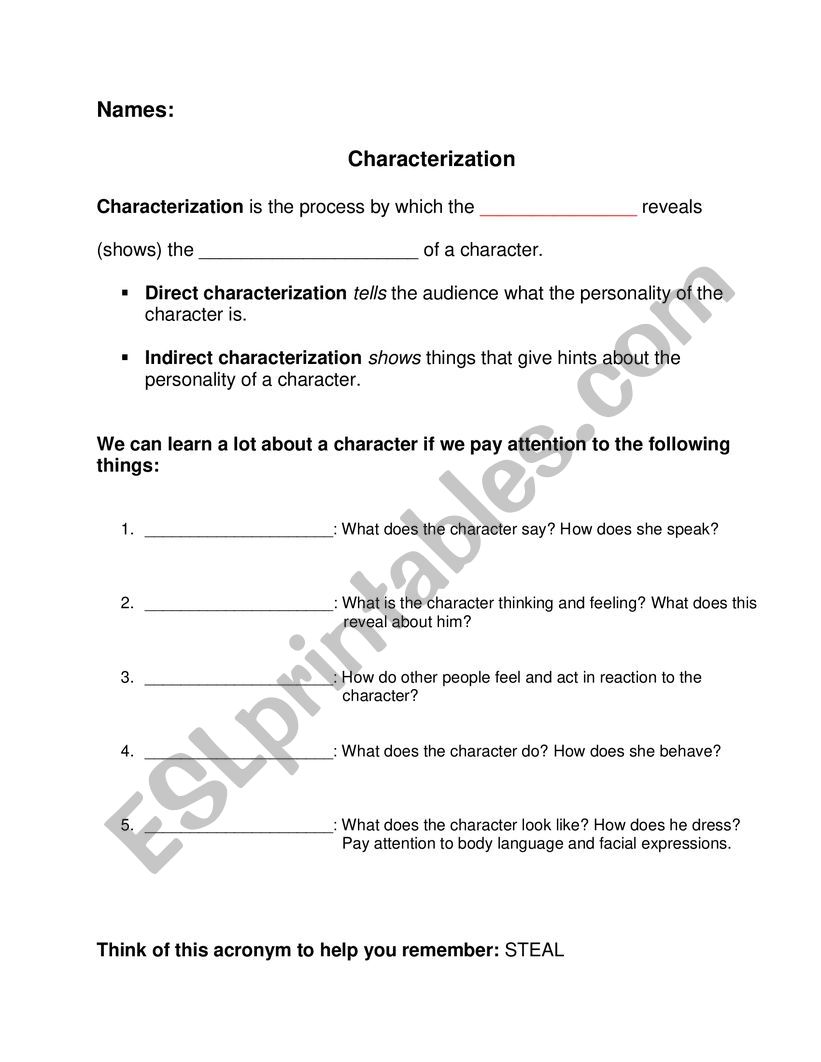Direct vs. Indirect Characterization: Unlocking Character Depth

In the world of storytelling, character depth and complexity often hinge on the techniques authors use to reveal their characters' personalities, motivations, and behaviors. Two primary methods are direct characterization and indirect characterization. Each method offers unique advantages and allows writers to craft compelling, multi-dimensional characters in different ways. In this blog post, we'll delve into both approaches, explore their uses, benefits, and how they can be integrated to create memorable characters.
Understanding Direct Characterization

Direct characterization occurs when the narrator or author explicitly tells the reader what a character’s personality, appearance, or background is like. Here’s how it works:
- Explicit Description: The author directly describes traits or features. For example, “John was a tall man with an imposing figure and a stern look on his face.”
- Narrator Insight: The narrator provides direct commentary or judgments about the character. “She was known for her kindness, often helping neighbors with their chores.”
Direct characterization is straightforward and can effectively convey basic traits quickly, but it might not engage readers as deeply as indirect methods.
Exploring Indirect Characterization

On the other hand, indirect characterization shows rather than tells. Here, readers infer character traits through:
- Actions: What characters do and how they react in various situations. For instance, “When the fire alarm sounded, Sarah was the first to evacuate, helping others along the way.”
- Dialogue: Their spoken words can reveal much about their personality, education, and background. “His accent was thick, rolling the ‘r’s in a way that suggested a childhood spent in Scotland.”
- Thoughts: Internal monologues or reflections give insight into their mindset. “He wondered, for the hundredth time, why he always felt like he had to prove himself.”
- Reactions: How characters react to other people or events tells a lot about them. “When faced with criticism, she’d always respond with a smile, her eyes hinting at a gentle defiance.”
- Physical Descriptions: Though less direct than naming traits, physical descriptions can suggest character traits. “Her wild, curly hair often looked untamed, much like her free spirit.”
👉 Note: Both direct and indirect characterization can be combined to provide a more rounded portrayal of a character.
The Benefits of Each Method

Here’s a quick comparison:
| Direct Characterization | Indirect Characterization |
|---|---|
| Provides instant insight into character traits. | Allows readers to discover traits through observation, making them feel more involved in the story. |
| Can be useful for establishing backstory quickly. | Develops character depth through natural unfolding, often leading to a more immersive experience. |
| Effective for minor characters where deep exploration isn’t necessary. | Better suited for protagonist development, enhancing reader’s emotional connection. |
| Risk of making characters feel flat if overused. | Requires more skill to execute effectively but results in complex characters. |

How to Use Direct and Indirect Characterization Together

Integrating both methods can enrich your narrative:
- Use direct characterization to set the stage quickly, especially at the beginning of the story or for secondary characters.
- Implement indirect characterization to reveal layers of a character over time, particularly through critical story moments or as part of the character arc.
- Balance the two based on the importance of the character to the story. Major characters usually benefit from both methods, while minor characters might be fleshed out with a simple direct description.
Here’s an example:
- Direct: “Anna was an introvert, more comfortable with her books than with people.”
- Indirect: Throughout the story, Anna is often seen reading alone in various settings, avoiding parties or group activities, showing her introverted nature through her actions and decisions.
By using both methods, you create an initial impression that's swiftly fleshed out by allowing the reader to witness the character's development in real-time, fostering a deeper connection and understanding.
Tips for Effective Characterization

To master the art of character portrayal:
- Show, Don’t Tell: While direct characterization is necessary, leaning on indirect methods can make characters more intriguing.
- Consistency is Key: Ensure that indirect characterization aligns with any initial direct traits given to a character.
- Use Dialogue: Characters should speak in a way that reflects their background and personality, providing a window into their psyche.
- Development Over Time: Show character growth or change through indirect cues rather than stating it directly.
- Unique Traits: Give characters distinguishing features or habits that make them memorable.
- Contrast: Create interesting dynamics by contrasting direct descriptions with indirect actions or behaviors.
In conclusion, direct and indirect characterization serve as two vital tools in an author's arsenal for crafting characters with depth and nuance. By understanding and effectively employing these techniques, writers can create a rich tapestry of personalities that drive the narrative forward. Whether through the narrator's telling or through the nuanced portrayal of actions, dialogue, and thoughts, characters come alive in ways that engage readers, making the journey through your story both memorable and impactful. The key lies in finding the right balance and allowing characters to breathe, evolve, and reveal themselves in ways that captivate and resonate with your audience.
What’s the difference between direct and indirect characterization?

+
Direct characterization involves explicitly describing a character’s traits by the author or narrator. Indirect characterization, on the other hand, allows the reader to infer traits through the character’s actions, dialogue, reactions, thoughts, and even physical descriptions.
Why is indirect characterization considered more engaging?

+
Indirect characterization encourages the reader to be an active participant in understanding characters. By piecing together actions, words, and thoughts, readers form a personal connection and develop a deeper understanding of characters, making the narrative experience more immersive and engaging.
Can these characterization methods be used for all types of characters?

+
Yes, but the approach might differ. Main characters often benefit from a mix of direct and indirect characterization to provide depth and relatability. For secondary or background characters, direct characterization might suffice to establish their role quickly within the story.